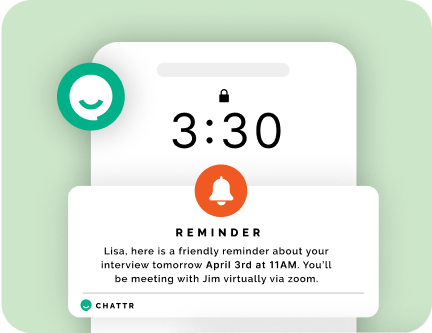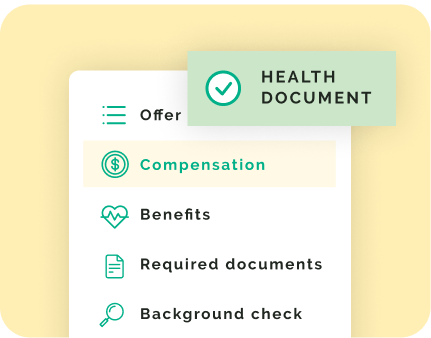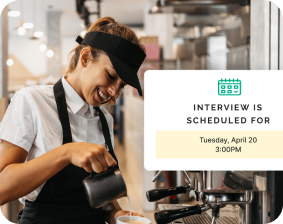Attracting and engaging high-quality talent is essential for recruitment success in today’s competitive hiring landscape. But how can you accurately track engagement levels to optimize your strategy?
Automated communication platforms provide the invaluable candidate data and insights you need. Let’s explore the key metrics to analyze, what the numbers reveal, and how to leverage the findings to boost engagement.
Understanding the Importance of Monitoring Engagement
Candidate engagement refers to applicants’ interest, attention, and responsiveness toward your employer’s brand and hiring process. Higher engagement directly translates into higher offer acceptance rates.
It’s important to keep candidates engaged throughout the hiring process. Engaged candidates are more likely to accept job offers and stay with the company longer, while disengaged candidates tend to reject offers and leave quickly. Poor engagement can also lead to higher hiring costs.
Tracking engagement metrics provides crucial visibility into your brand traction and where candidates may be falling through the cracks. Automation unlocks insights that are impossible to gather manually.
Key Engagement Metrics Tracked Through Automation
Sophisticated automated platforms like chatbots, texting, and email sequencing allow extensive tracking from first touch to hire. Vital metrics include:
Application Submission Rate
The percentage of prospects completing applications after initial outreach is a sign of early engagement. Lower rates demand attention.
Email Click-Through Rate
The share of candidates that click CTAs and links in outreach emails signals interest. Higher click-through is positive.
Assessment Completion Percentage
The number of applicants who finish skills assessments reflects engagement. High drop-off warrants evaluation.
Interview Attendance Rate
The percentage of scheduled interviews attended indicates declining engagement needs to be higher. This metric needs monitoring.
Offer Acceptance Ratio
The share of made offers accepted: Low rates suggest engagement gaps causing rejections.
Time-To-Respond
The average time taken by candidates to respond to emails/texts. Quicker responses equal higher engagement.
Net Promoter Score
Candidate willingness to recommend your process to others. Higher scores signal strong engagement. Automation provides engagement tracking that is impossible manually.
Analyzing Data for Recruitment Strategy Insights
The metrics above offer more than superficial data. Digging deeper reveals where and why candidates disengage, allowing tailored solutions.
Low Application Rates
If your application rates dip, it signals immediate disengagement with your job posts. Make descriptions more compelling by highlighting culture, growth, and rewards.
Minimal Clicks
Declining click-through rates indicate your CTAs and email content need optimization. Test new calls-to-action and messaging that resonate.
Incomplete Assessments
High assessment drop-off may reflect overly long or irrelevant tests. Shorten assessments and tailor them closer to required job skills.
Missed Interviews
Frequent interview no-shows likely result from a drawn-out hiring process. Accelerate scheduling and times-to-hire.
Rejected Offers
Beyond compensation, offer rejections could be due to poor experience. Improve communication, transparency, and speed.
Lengthy Response Times
Gradually longer response times signal waning interest. Set up automated nurture streams to re-engage unresponsive candidates.
Mediocre Promoter Scores
Lukewarm recommendations indicate needed improvements. Prioritize changes based on verbatim feedback. Acting on each metric’s insights boosts engagement.
Candidate Engagement Insights from Metrics Analysis
Here are examples of specific insights metrics analysis provides:
- – Low weekend application rates show that dedicated weekend response staffing is needed.
- – Higher completion on mobile reveals that your process needs optimization for mobile.
- – Slowing responses after interviews highlight the need for post-interview updates.
- – Declining email click-through rates suggest testing new personalized subject lines.
- – Many candidates never respond after the third interview means confirming continued interest.
The right data can spotlight specific reasons for disengagement at different stages for tailored resolution.
Enhancing Recruitment Efficiency Through Metrics Insights
Here are three proven examples of companies using engagement insights to improve:
Optimize Job Descriptions
Airbnb used application rate data to diagnose vague job descriptions. Adding culture and impact details increased submissions by 26%.
Refine Assessments
Spotify’s completion metrics showed redundant tests. Streamlining pre-employment assessments reduced drop-offs by 46%.
Improve Interview Experience
Long interview delays caused frequent no-shows for Nestle. Accelerating scheduling increased attendance by 65%.
Purposeful metrics analysis provides a clear roadmap to boosting candidate engagement.
Key Takeaways
- – Candidate engagement metrics indicate interest and participation in your brand and process. Higher engagement drives offer acceptance.
- – Key metrics like application completion rate, interview attendance percentage, and offer acceptance ratio provide actionable insights when tracked through automation.
- – Analysis uncovers specific reasons candidates disengage at different stages, whether vague job posts, redundant assessments, or delays.
- – Addressing identified issues results in major improvements in cost per hire, hiring velocity, and talent quality.
In today’s competitive hiring, the advantage goes to recruiters who effectively attract and engage talent. Robust candidate engagement metrics and insights enabled by automation provide the blueprint to optimize your strategy.
Final Thoughts
Candidate engagement is the key recruitment differentiator today. But you can’t improve what you don’t measure. Automated platforms unlock previously inaccessible metrics and granular insights that diagnose engagement pain points.
Tracking submission rates, assessment completion, interview attendance, and offer acceptance shines a spotlight on where candidates lose interest. Addressing identified disengagement drivers at each hiring stage translates to increased offer acceptance, shortened time-to-hire, and reduced cost per hire through higher-quality hires.
Leveraging candidate engagement metrics provides the playbook to enhance your end-to-end recruitment strategy. Move beyond guesswork and make data-backed improvements for hiring excellence.












